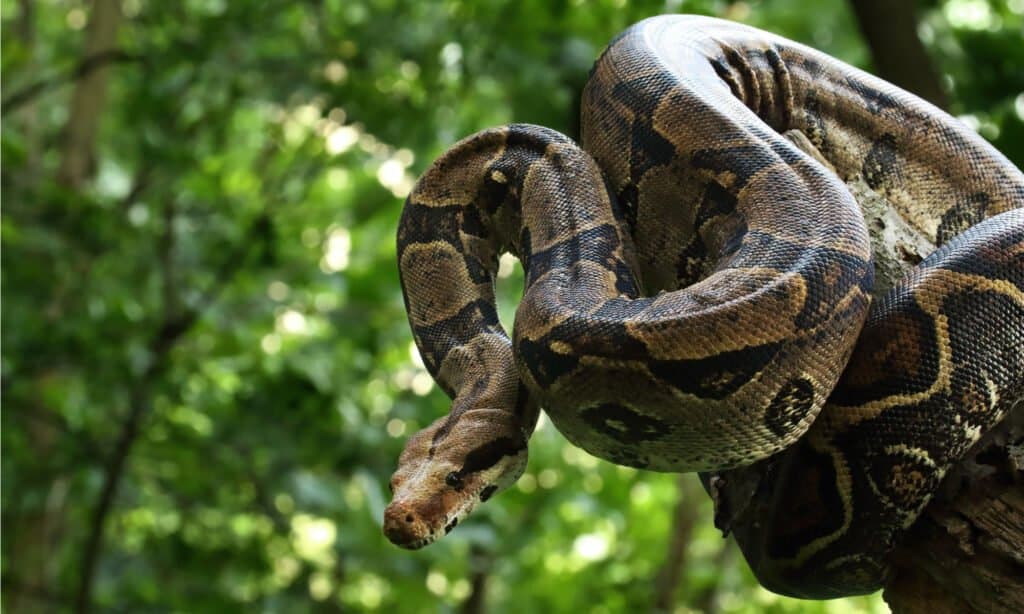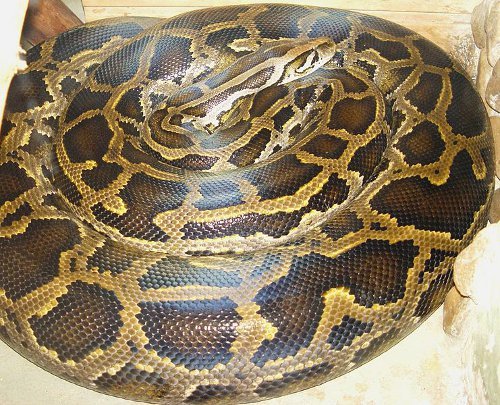The characteristics of a Boa constrictor include a tan or light brown background coloration, a light-colored mottled belly with dark spots or smudges, and a tannish top of the head with a thin, dark stripe down the middle. They also have dark elongate markings behind the eyes that are bordered by white below.
Boa constrictors are native to parts of North, Central, and South America and are nonvenomous. They can be found in a variety of habitats, ranging from tropical rainforests to arid semi deserts, but they prefer to live in rainforests due to the higher humidity.
Boa constrictors are fairly modest-sized boids and are commonly kept in captivity.

Credit: www.amazon.com
Introduction To Boa Constrictor
The Boa Constrictor, scientifically known as Boa constrictor, is a large nonvenomous snake that belongs to the family Boidae. These fascinating reptiles are native to parts of North, Central, and South America and have gained popularity as exotic pets due to their impressive size and relatively calm temperament. In this article, we will explore the natural habitat, physical appearance, and other interesting details about the Boa constrictor species.
Natural Habitat
The Boa Constrictor inhabits a diverse range of environments within their natural habitats, including tropical rainforests, semi-arid regions, and even some coastal areas. These snakes are highly adaptable and can be found in various countries such as Mexico, Brazil, Bolivia, and Venezuela. They are particularly adept at climbing and can be found in trees, as well as on the ground.
Physical Appearance
Boa Constrictors are known for their impressive size and stout build. They can grow up to 10 feet long, with some individuals reaching lengths of up to 13 feet. The coloration of their scales can vary greatly depending on their specific location and genetic variations.
Their bodies are covered with smooth scales that have a glossy appearance. The overall background coloration is usually tan, light brown, grayish brown, or cream colored. The belly is light-colored and may be mottled with dark spots or smudges. The top of their head is tannish, with a thin, dark stripe down the middle. Behind their eyes, you can find dark, elongate markings that are often bordered by white below.
These fascinating snakes have a muscular body, which allows them to constrict their prey tightly. They have a series of sharp teeth, positioned in rows, and a hooked snout. Unlike venomous snakes, Boa Constrictors rely on their powerful muscles to subdue and suffocate their prey.
In conclusion, the Boa Constrictor is a captivating snake species with a widespread distribution in the Americas. Its impressive size, adaptability, and distinctive physical appearance make it a popular choice among reptile enthusiasts. Understanding their natural habitat and physical characteristics is essential for providing appropriate care and ensuring their well-being as pets.
Species Of Boa Constrictor
The Boa Constrictor is a fascinating species of snake that is native to parts of North, Central, and South America. It belongs to the genus Boa and is known for its impressive size and nonvenomous nature. There are several different species of Boa Constrictor, each with its own unique characteristics and features. In this article, we will explore the number of species, identification features, and the rarest species of Boa Constrictor.
Number Of Species
There are approximately 10 recognized species of Boa Constrictor. These species vary in size, coloration, and habitat preferences. Some of the most well-known species include:
- Boa Constrictor Imperator: Also known as the Common Boa, this species is native to Central and South America. It is one of the most commonly kept in captivity and can reach lengths of up to 10 feet.
- Boa Constrictor Constrictor: This species is found in parts of South America, including Brazil and Argentina. It is known for its vibrant coloration, with red or orange patterns on its body.
- Boa Constrictor Longicauda: Native to Mexico, this species is characterized by its long tail, which makes up a significant portion of its overall length.
Identification Features
Boa Constrictors can be identified by a few key features. These include:
- The background coloration, which is usually tan, light brown, grayish brown, or cream colored.
- The belly, which is light-colored and mottled with dark spots or smudges.
- The top of the head, which is tannish with a thin, dark stripe down the middle.
- Dark, elongate markings behind the eyes that are often bordered by white below.
These identification features may vary slightly between different species of Boa Constrictor, but they provide a general guide for recognizing this snake species.
Rarest Species
One of the rarest species of Boa Constrictor is the Boa Constrictor Sabogae. This species is found only on the island of Saboga in the Gulf of Panama. It is critically endangered due to habitat loss and predation by invasive species.
Another relatively rare species is the Boa Constrictor Longicauda, also known as the Mexican Long-tailed Boa. This species is native to Mexico and is characterized by its long tail compared to other Boa Constrictor species.
These rare species highlight the need for conservation efforts to protect the diversity of Boa Constrictors and their natural habitats.
Caring For Boa Constrictors As Pets
If you’re considering a boa constrictor as a pet, it’s important to understand how to properly care for this fascinating snake species. Boa constrictors are native to parts of North, Central, and South America and are known for their large size and impressive strength. Despite their intimidating appearance, with the right care and attention, boa constrictors can make wonderful pets. In this section, we will explore everything you need to know about caring for them.
Native Range And Behaviour
Boa constrictors have a wide native range, spanning from North America all the way down to Argentina. They can be found in a variety of habitats, including forests, swamps, and grasslands. In terms of behavior, boa constrictors are known for their docile nature and relatively calm disposition. They are typically non-aggressive and rarely bite unless they feel threatened.
Care Tips
Here are some care tips to ensure the health and well-being of your boa constrictor:
- Enclosure: Provide a spacious enclosure with enough room for the snake to stretch out and move around. A glass or plastic tank with secure ventilation is ideal.
- Temperature and Humidity: Maintain a warm side of the enclosure between 85-90°F (29-32°C) and a cool side between 75-80°F (24-27°C). Keep the humidity levels around 60-70%.
- Feeding: Boa constrictors are carnivores and require a diet of appropriately sized frozen-thawed rodents, such as mice or rats. Offer food once every 1-2 weeks, adjusting the prey size as your snake grows.
- Handling: Handle your boa constrictor with care and confidence, ensuring that you support its body and avoid sudden movements. Regular handling helps to establish trust and maintain a healthy bond.
- Cleaning: Regularly clean the enclosure by removing waste and sanitizing the tank to prevent the buildup of bacteria or parasites.
Comparison With Other Snake Species
When compared to other snake species, boa constrictors have some unique characteristics and care requirements. Unlike venomous snakes, boa constrictors are non-venomous and rely on constriction to subdue their prey. Due to their large size and muscular build, boa constrictors need more space and a secure enclosure. Additionally, boa constrictors have a slower metabolism compared to some other snake species, which means they require less frequent feeding.

Credit: pubs.usgs.gov

Credit: a-z-animals.com
Frequently Asked Questions Of Boa Constrictor: Species Profile
What Are The Characteristics Of A Boa Constrictor?
Boa constrictors have a tan or light brown background color with dark spots or smudges on their light-colored belly. They also have a tannish head with a thin dark stripe down the middle and elongate markings behind the eyes. They are nonvenomous and can be found in parts of North, Central, and South America.
How Many Boa Constrictor Species Are There?
There are multiple species of boa constrictors, but the exact number is unclear.
How Do You Identify A Boa Constrictor?
A boa constrictor can be identified by its tan, light brown, or grayish brown background coloration. Its belly is light-colored with dark spots or smudges. The top of its head is tannish with a thin, dark stripe down the middle.
It has dark, elongate markings behind the eyes.
What Is The Rarest Species Of Boa?
The rarest species of boa is the Puerto Rican Boa (Epicrates inornatus). It is the largest snake found in Puerto Rico and is not venomous.
Conclusion
The boa constrictor is a fascinating species with unique characteristics that make it stand out among other snakes. From its tannish head with a dark stripe down the middle to its mottled belly with dark spots, this snake is truly a sight to behold.
Boa constrictors can be found in various habitats, from tropical rainforests to arid semi-deserts. Although they are nonvenomous, they are skilled hunters and can subdue large prey with their powerful muscles. If you’re considering a pet snake, boa constrictors are a great choice, as they adapt well to captivity.
Overall, the boa constrictor is a remarkable species that deserves our admiration and respect.

